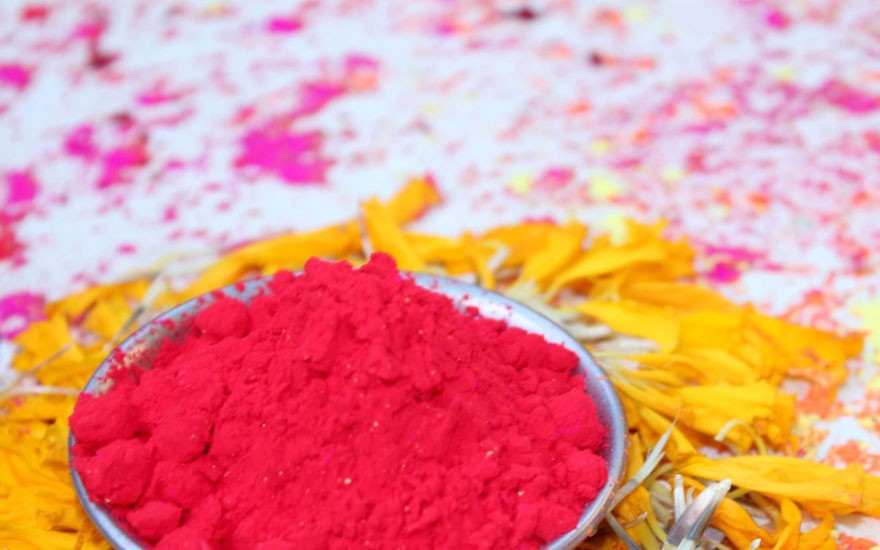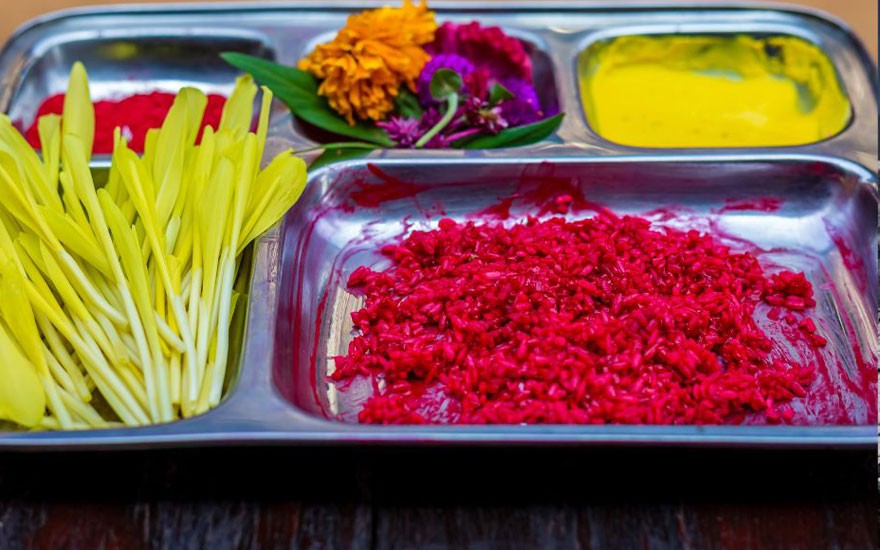
Trekking in Nepal
By Alpine

Dashain and Tihar are considered to be the biggest Hindu festivals in Nepal. It is celebrated nation-wide by the followers of Hinduism and gets the most amount of holidays. The celebration is done with the gathering of family and friends, doing puja, and eating good food. It is the festival to celebrate happiness and prosperity among each other. It is a festival where people who are living away return to their homes.
Dashain, also known as Bijaya Dashami, falls around September or October, which depends on the Nepali calendar known as Bikram Sambat, which is approximately 57 years ahead of the English Gregorian calendar. It is the longest celebrated festival in Nepal, which lasts 15 auspicious days. The first, seventh, eighth, ninth, tenth, eleventh, and fifteenth days are the most widely observed of the fifteen days that are designated for the celebration.
The name “Bijaya Dashami” or “Bada Dashain” means the “big tenth day.” It is the most important day of the entire festival and is celebrated by surrounding your friends and families. It is also the end of the ninth day known as Nauratha, where the goddess Durga is worshiped.
Ghatasthapana marks the beginning of the 15-day long festival. Ghatasthapana, meaning sowing seeds of Jamara by placing a Kalash, which is viewed as the Goddess Durga. A sand bed is made seeded with grains of barley and maze. Then puja is performed every day till the seventh day, where the jamara will have grown 5-6 inches long of green and yellow grass. And finally, on the tenth day, the jamara will be ready to take out and use for the main ceremony.
Another major day of the festival is the seventh day, known as "Phulpati.” The word “Phulpati” consists of two words: "Phul,” meaning flower, and "Pati,” meaning leaf. On this day, the Nepal Army is lined up in the Basantapur Durbar Square, where they fire shots to the sky as a symbol of honoring Phulpati. At home, puja is done where the sprouts are offered nine different types of flowers with leaves, which are associated with different goddesses.
This day puja is conducted to appease the fiercest goddess, Durga, and her manifestation, Kali. Animals such as goats, buffalos, roosters, and ducks are sacrificed in different goddess temples all over Nepal. Kathmandu Durbar Square is one of the main places where a large number of sacrifices are offered. The blood is offered to the goddess, and afterwards a feast is hosted where the blood and meat are cooked as the entire family enjoys the festival.
The Maha Navami, which is the “great ninth day," is the last day of Nauratha. It is the only day the temple of Taleju Bhawani in the Kathmandu Durbar Square opens for the public for performing pujas and sacrifices of animals. The 21 guns salute are fired while buffalo’s are being sacrificed in the Kot courtyard of the Hanuman Dhoka Palace. On this day, artisans, craftsmen, traders, and mechanics worship and offer animal and fowl blood to their tools, equipment, and vehicles.
This is the tenth and biggest day of the entire festival. The tika is prepared by mixing rice, yogurt, and powdered vermilion known as anbir. The jamara that was planted on the first day will be ready to cut and wear. Every year, the most auspicious time for putting tika differs. The Hindu priests give out the exact time to put tika, and it begins by putting tika by the eldest member of the family; more often than not, it is the grandparent.
The elders put tika and jamara on the younger ones of the family and give "Dakshina,” which is usually money, as a form of blessing. This continues till the full moon day, and during that time period, families and relatives living in different places come and go to each other’s home to receive tika and blessings and enjoy the feast while playing cards, music, and dancing.
Ekadashi is the eleventh day of the lunar calendar and considered auspicious. Generally people take fast during this day and go to temples and dedicate themselves to spiritual gain by taking holy showers and eating foods that are considered holy. Papakunsha Ekadashi is the day after Dashami. Some people fast on the occasion of Ekadashi but most continue the feast and celebration. Relatives come to the house to put tika on this day too.
The last day, which is also the full moon day, the Dashain festival finally comes to an end. Goddess Laxmi, who is known as the “Goddess of Wealth,” is worshiped, and it is believed that she descends down on earth and blesses us with wealth and well-being.
While Dashain is all about celebrating by putting tika and jamara in the hands of our elders, receiving blessings, feasting, and enjoying the days by having all your family members around, Tihar is all about lights and colors. Tihar is also known as Deepawali or Yama Panchak. Tihar is also called Deepawali because "diyo,” an oil lamp, is lit all around the house during this festival. And it is called “Yama Panchak” because four beings that are associated with the god of death, "Yama,” are worshiped during the festival. The Tihar festival is of five days, where the final day is reserved as rest day, but the remaining four days have a religious and cultural significance.
These four days include the following:
The very first day of Tihar is known as “Kaag Tihar,” kaag meaning crow. On this day the crows and ravens are offered seeds, grains, and other preferred food on a leaf as an offering to them. They are known as the messengers of death god Yama. It is believed that the god of death will be happy and protect them from the misfortune of death and injuries in the family.
Kukur, which means dog in Nepali, is worshiped on this day. All the dogs in the country, pets and stray dogs, are worshiped by putting tika and flower chains of marigold around their necks. It signifies the pure relationship between humans and dogs and is an appreciation day for their love and loyalty. It is also believed that dogs guide you to the gates of heaven after death. Therefore, on this day the dogs are loved and appreciated by offering them their favorite food.
This is definitely the most anticipated day of Tihar. On this day, the holy animal cow, which is also the national animal of Nepal, is worshiped. The cow is considered a part of the goddess Mahalaxmi, the goddess of wealth. Thus, during the morning, the cows are worshiped by putting tika and marigold flower chains around their necks. The stamp of red and white tika is put all around their bodies by flowers. Then they are offered foods such as fruits, vegetables, flour, etc. as a sign of appreciation. This morning, people spend their time going to temples and making long chains of marigold flowers to decorate the doors and windows of their homes. For the evening puja, the house is also thoroughly cleaned, and blinking lights are installed throughout.
Then once the evening falls, people start preparing for Laxmi Puja. A mandala of bright colors is made on the front yard of the home called “rangoli.” A pathway is created from outside to inside of the room where the picture of the goddess Laxmi is kept. Diyos are lit all over the house along with the blinking colorful lights. The home is kept bright in hopes that Laxmi, the goddess of wealth, will come and bless us with good fortune.
Furthermore, kids and young adults go and play “deusi and bhailo," where they go from house to house singing a specific bhailo song and receive money from the home owners.
Another special day of Tihar, and on this day, ox and the mountain Ghovardhan are worshiped. The ox are appreciated for the help of labor they provide for agriculture. And the mountain of Ghovardhan is made from cow dung and worshiped.
Another special occasion on this day is Mha puja. Mha, which means "me,” where one worships themselves and their soul, appreciating the self's existence. The Newar communities solely perform this puja. It is also a new year in Nepal, Sambat, which is another Nepali calendar.

The fifth and final day of Tihar is called Bhai Tika, where brothers and sisters worship each other. On this blessed day, sisters perform puja on their brothers, where they pray for their long life and ward off harm by creating a barrier and putting a special mala made up of Makhamali (Gomphrena globosa). The sister gives their brothers clothes and food they prepared themselves and the brothers, in exchange, bow down with their foreheads touching the sister’s feet and give money and clothes as gifts.
These festivals are part of Nepalese culture and religion. They provide an opportunity for all of the families and friends to gather and spend time together. It is all about creating a space where everything around us is respected and appreciated. But this time is also the best time to go trekking in the mountains. People who do not celebrate these festivals spend their time visiting different places, especially trekking.Short 12 Days Everest Base Camp Tour or Classic Everest Base Camp Trek, Annapurna Base Camp Trek, and Langtang Valley Trek are some of the popular destinations among the people. Alpine Ramble Trek can organize the best trip for you with the best services. For more details, email us at alpineramble@gmail.com or WhatsApp at +977 985-1175531, and let us be at your service.